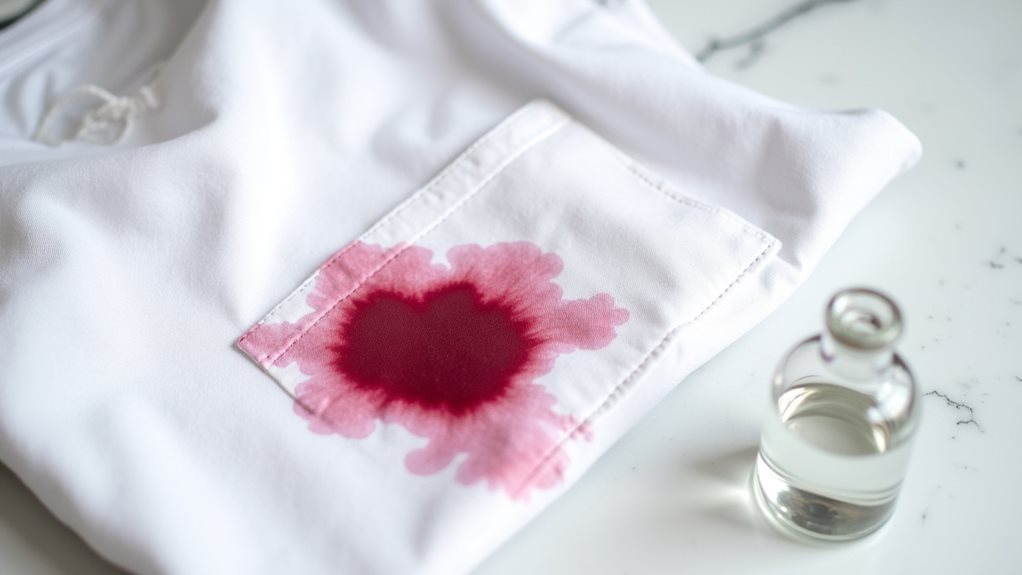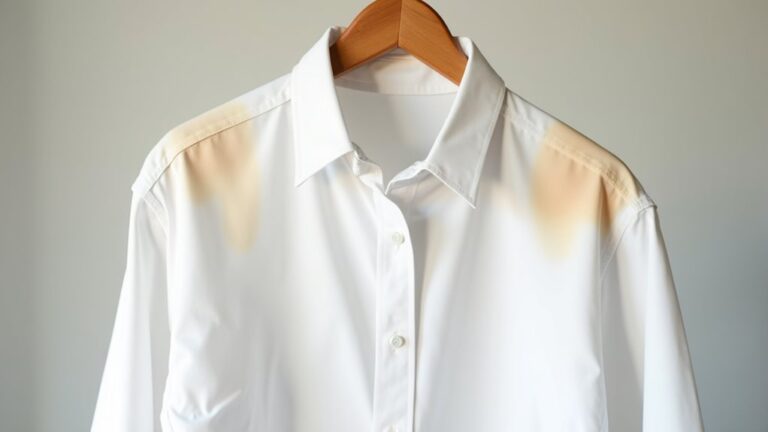Yes, dry cleaning can remove many color stains that seem impossible to tackle at home, and I’ve watched professional cleaners work magic on everything from pen ink disasters to red wine mishaps on delicate silk blouses. The specialized solvents penetrate deep into fabric fibers, breaking those stubborn dye bonds without the harsh scrubbing that damages your favorite pieces, though success depends on the stain’s age and your fabric type—and there’s so much more to this process.
Understanding Color Stains and Dye Transfer
When I first discovered a bright red sock had somehow snuck into my load of white dress shirts, I learned the hard way that color stains aren’t just surface-level accidents—they’re actually tiny dye molecules that have formed chemical bonds with your fabric’s fibers, creating what professionals call “dye transfer.”
You’ve probably experienced this frustrating phenomenon yourself, whether it’s from a leaky pen in your shirt pocket, a splash of cranberry juice at dinner, or that one rebellious garment that decides to share its color with everything else in the wash.
Understanding how dye stains work helps explain why professional dry cleaning with specialized chemicals offers more effective treatment than scrubbing frantically with soap—quick action and oxidizing agents can break those stubborn molecular bonds for successful stain removal.
While dry cleaning excels at removing many stubborn stains, chemical solvents work differently on various stain types, making some color stains more challenging to eliminate than oil-based or grease stains.
How Dry Cleaning Solvents Work on Color Stains
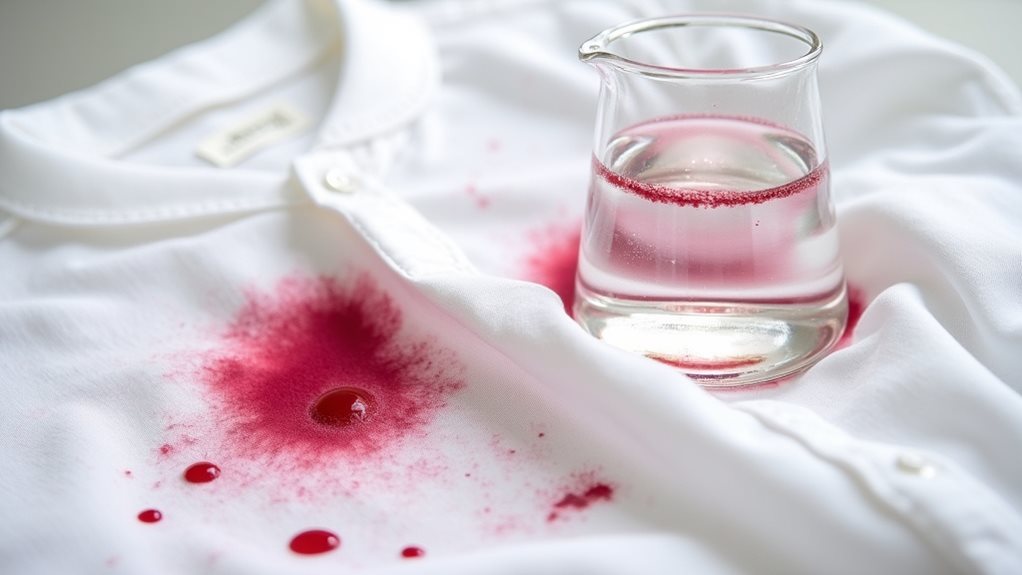
While water-based cleaning methods fundamentally push around the surface of stubborn color stains like you’re trying to sweep dust with a wet mop, dry cleaning solvents actually dive deep into your fabric’s fibers, working at the molecular level to break apart those pesky dye bonds that are clinging to your favorite garments for dear life.
These specialized solvents can remove color stains without the harsh scrubbing that damages delicate fabrics. Professional dry cleaners strategically use oxidizing agents and solvent-based spotters, selecting the perfect chemical cocktail for your specific stain situation.
This targeted approach preserves garment quality while achieving successful removal, which honestly feels like magic when you get back that white shirt you thought was ruined forever! 😊
This specialized cleaning method is particularly effective for delicate fabrics like silk, wool, and cashmere that can be damaged by water and traditional washing methods.
Types of Color Stains That Can Be Successfully Removed
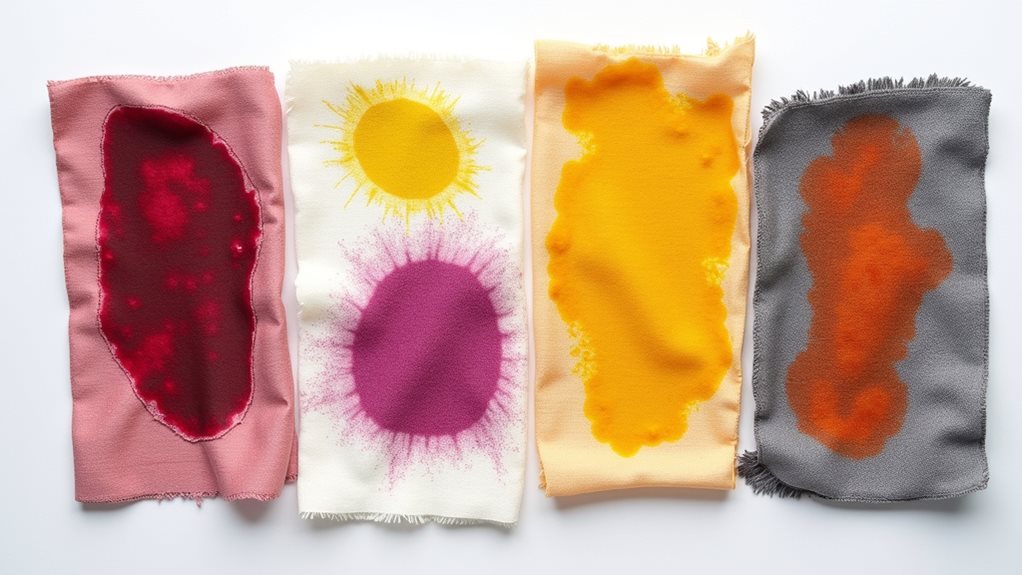
Knowing how these powerful solvents work their molecular magic is helpful, but let’s talk about the specific culprits that actually respond well to professional treatment, because honestly, not every colorful mess on your clothes is created equal.
Professional dry cleaners excel at tackling dye stains from pen ink and permanent markers—those panic-inducing marks that make your heart sink. Food color stains from mustard, turmeric, and berries also surrender to specialized solvents, while tannin-based stains like red wine stains and coffee respond beautifully when treated promptly.
Even dye transfer from bleeding garments can often be lightened considerably. The real magic happens when oxidizing agents break down stubborn color bonds on delicate fabrics without causing damage—something your washing machine simply can’t achieve. However, protein-based marks like sweat or blood also respond particularly well to dry cleaning’s chemical solvents, making it an effective solution for a broader range of staining substances than many people realize.
Specialized Treatments for Stubborn Dye Stains
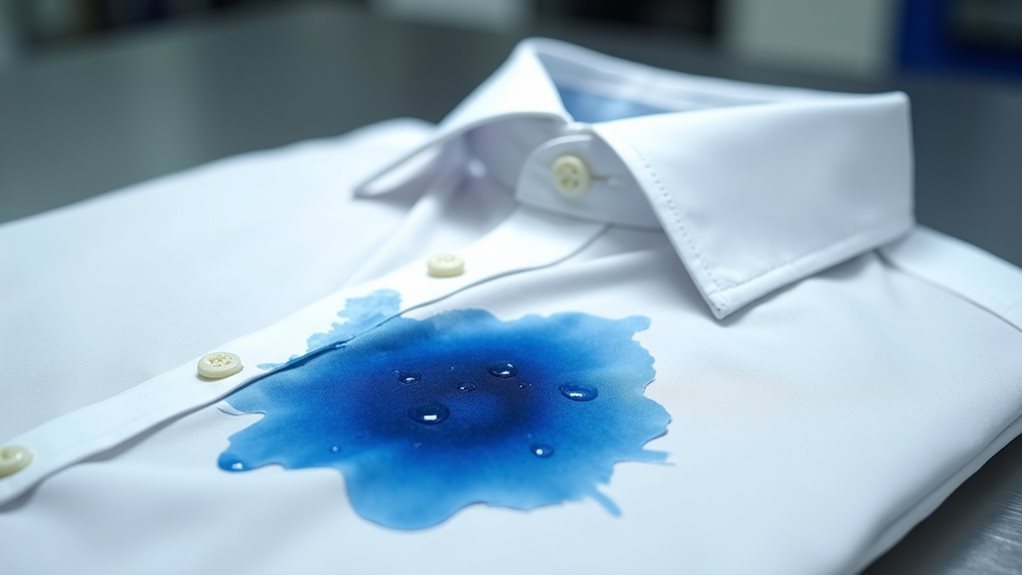
The success of color stain removal largely depends on factors such as how long the stain has been set, the fabric material, and whether any previous attempts at removal have been made.
Fabric Considerations When Removing Color Stains
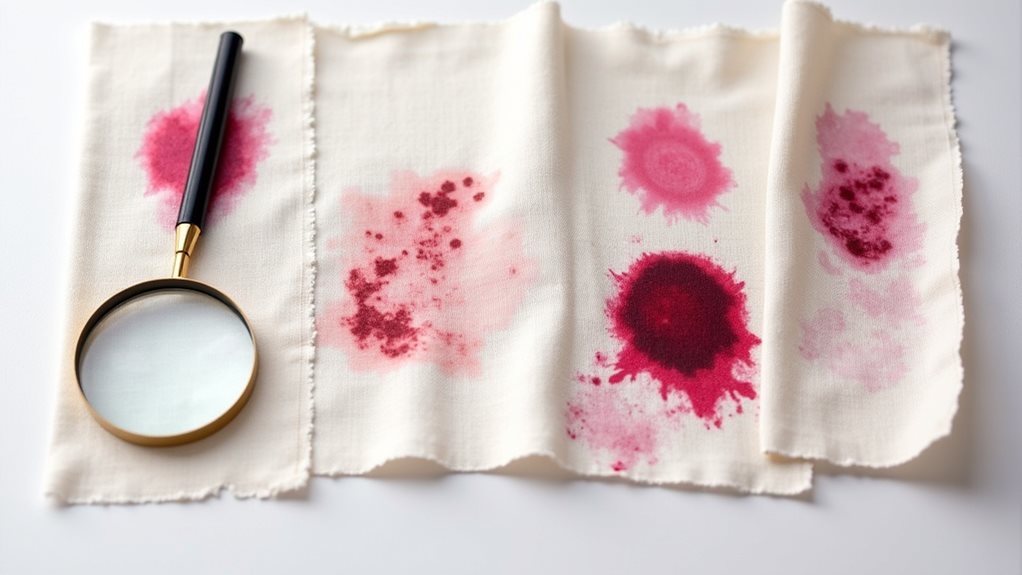
Your fabric choice determines whether that color stain becomes a success story or a heartbreaking goodbye to your favorite piece.
When dealing with fabric considerations for color stains, delicate materials like silk and wool demand gentle handling, while cotton might withstand more robust treatments.
Professional dry cleaners assess your garment’s fabric composition and stain characteristics before selecting appropriate methods, because preserving garment integrity matters as much as stain removal.
Vibrant colors and prints require extra caution since aggressive stain removal can cause additional discoloration—I’ve learned this lesson the hard way with a beloved floral dress 😅.
The colorfastness of your fabric plays a huge role in determining success rates, so always share detailed information about both the stain and fabric with your cleaner for best results.
Dry cleaning’s use of chemical solvents instead of water creates less stress on fabric fibers and dyes, making it particularly effective for treating stains on delicate materials without causing additional color damage.
When Home Remedies Fail and Professional Help Is Needed
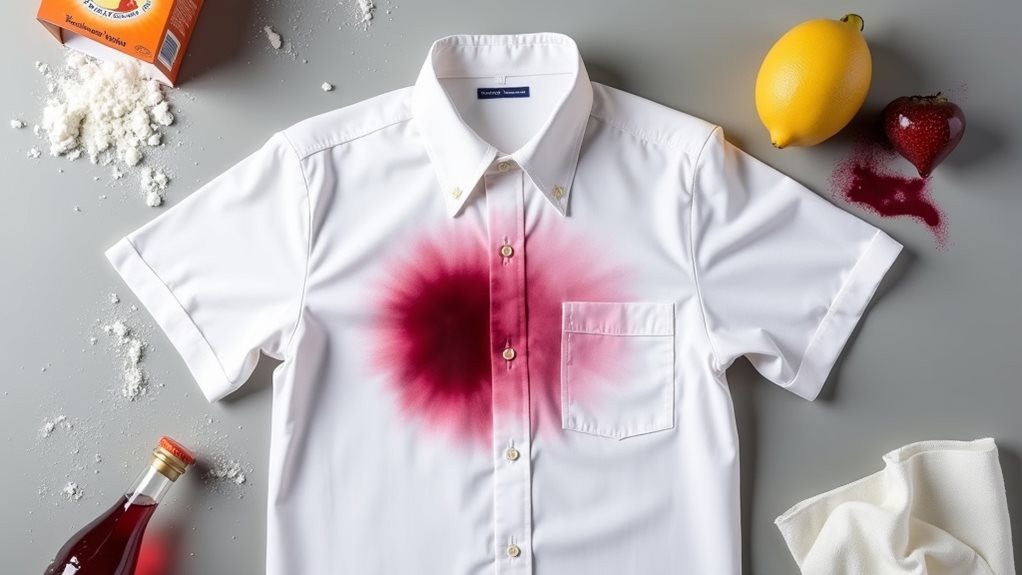
Although I’ve tried every Pinterest hack and grandmother’s remedy imaginable, there comes a humbling moment when you realize that stubborn color stain isn’t budging—and that’s when it’s time to wave the white flag and call in the professionals.
Here’s when you’ll need professional dry cleaning services instead of wrestling with home remedies:
- Delicate fabrics like silk or wool require specialized stain removal methods that won’t damage the fibers during treatment.
- Oil-based stains and permanent marker mishaps need enzyme-based solutions and cleaning agents that aren’t available in your kitchen cabinet.
- Quick action becomes critical—waiting too long transforms manageable stains into fabric nightmares that even professional dry cleaners struggle with.
Professional dry cleaners use specialized chemical solvents instead of water, making them particularly effective at removing stubborn stains that have set into clothing fibers.
Sometimes admitting defeat isn’t failure; it’s smart strategy!
Best Practices for Color Stain Prevention and Treatment
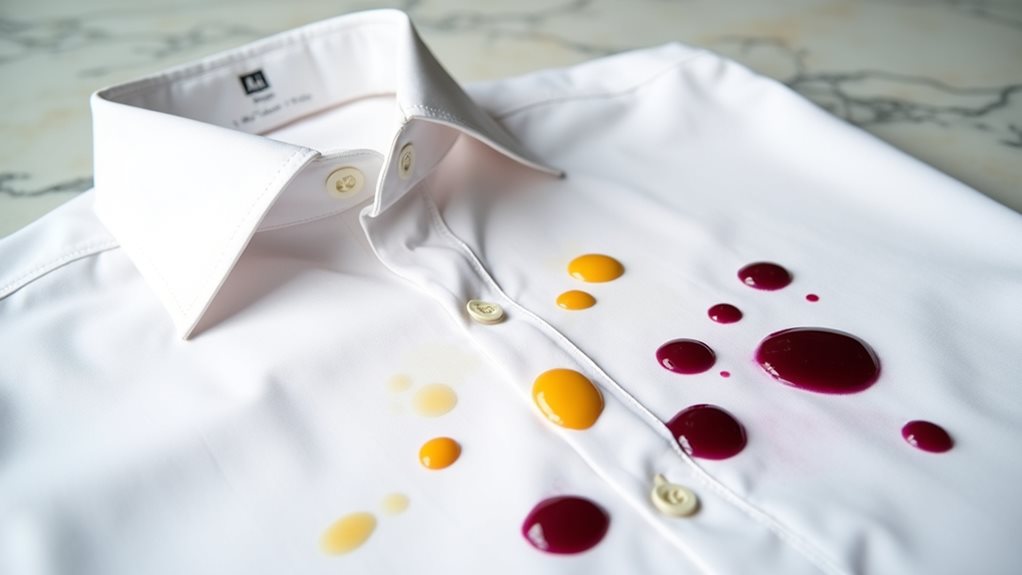
While calling professionals can save the day when disaster strikes, I’ve learned through countless wardrobe mishaps that preventing color stains in the first place is like wearing a seatbelt—it’s way easier than dealing with the aftermath.
Here’s my hard-earned wisdom: always check care labels before washing, separating clothes by color to prevent color stains through avoiding dye transfer.
When accidents happen, promptly treat stains with cold water and gentle blotting—never hot water, which sets dyes permanently.
For delicate fabrics, test any stain treatment solution on an inconspicuous area first to avoid further damage.
Since dry cleaning uses chemical solvents instead of water, it can be particularly effective for certain dye stains that water-based cleaning methods might not handle.
Sometimes you’ll still need a professional dry cleaner for stubborn stains, but these preventive steps help you tackle removing stains without damaging your favorite pieces.

